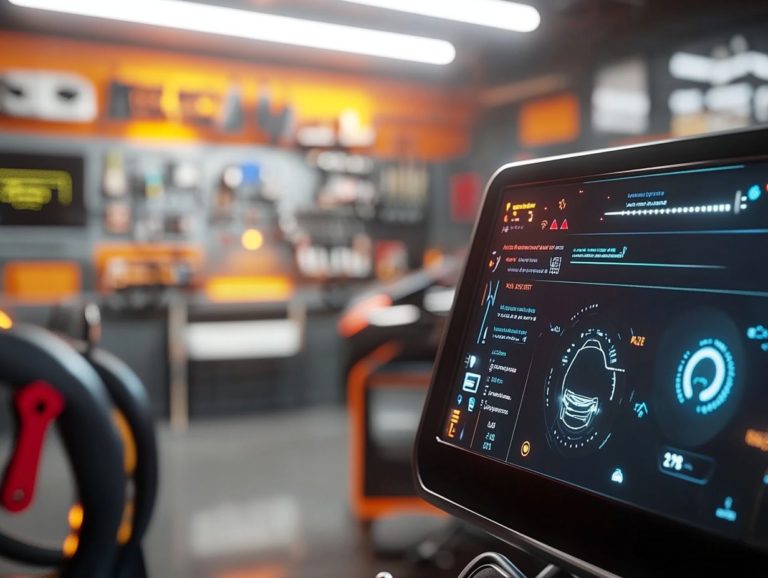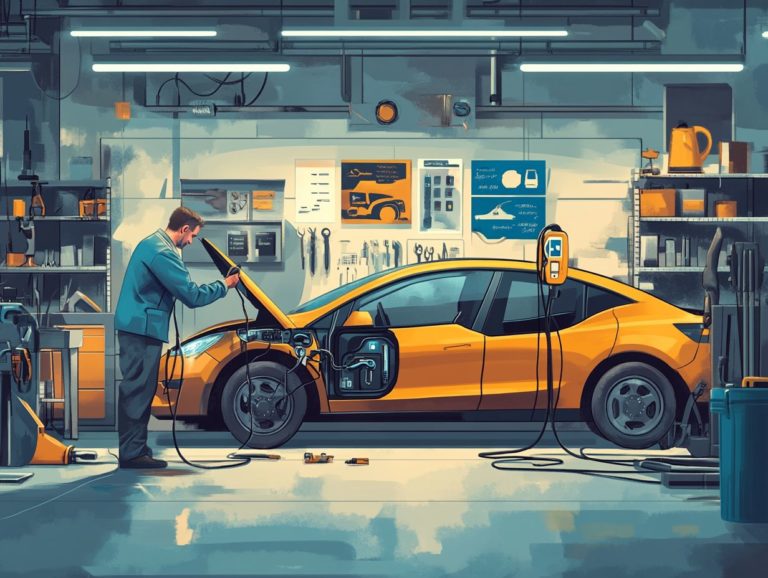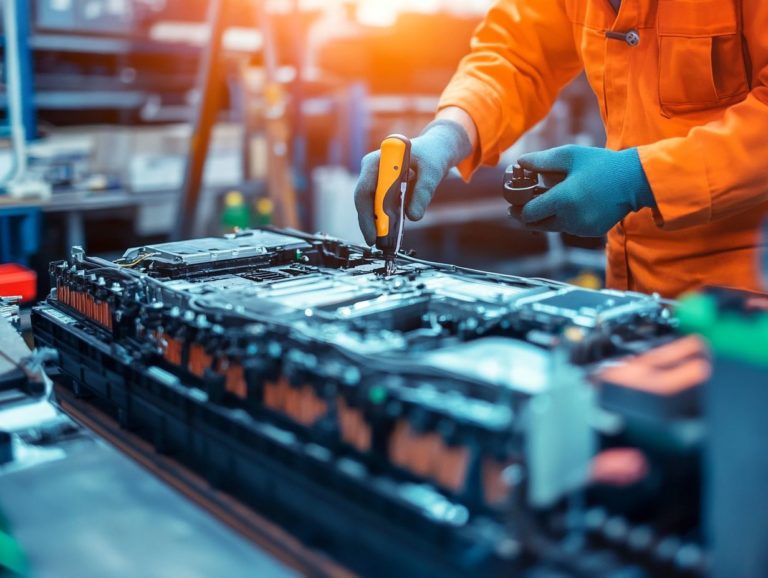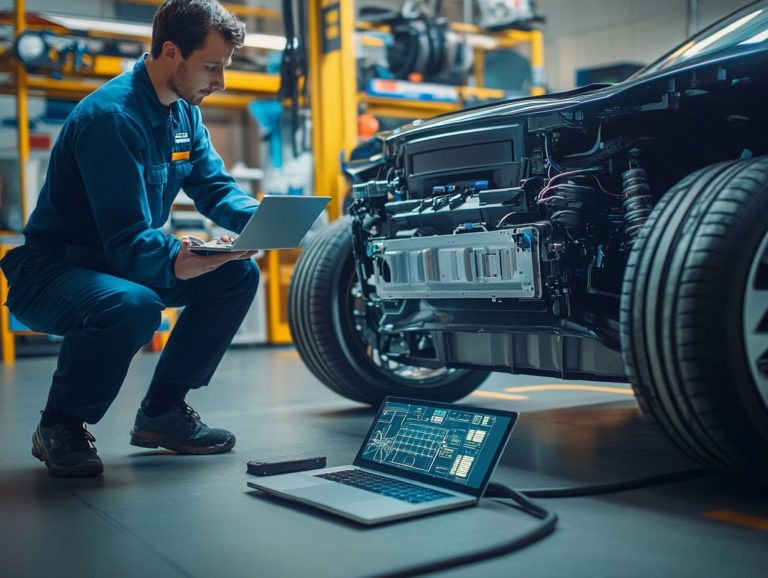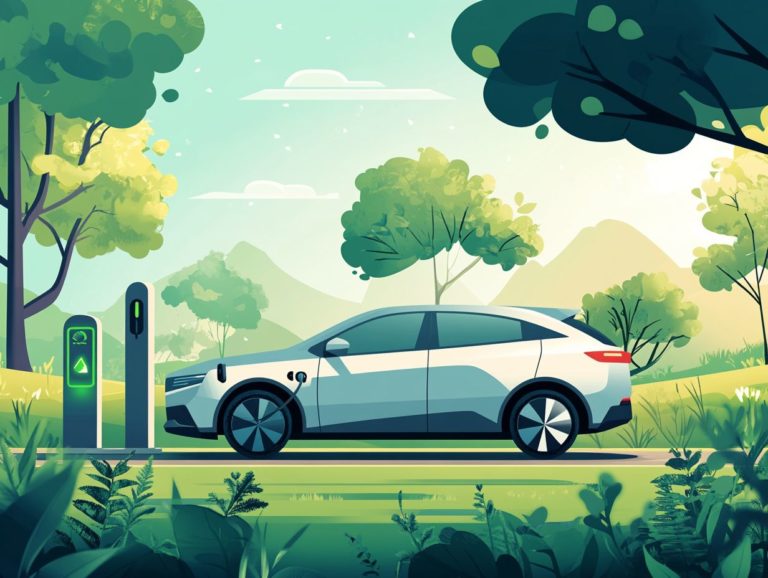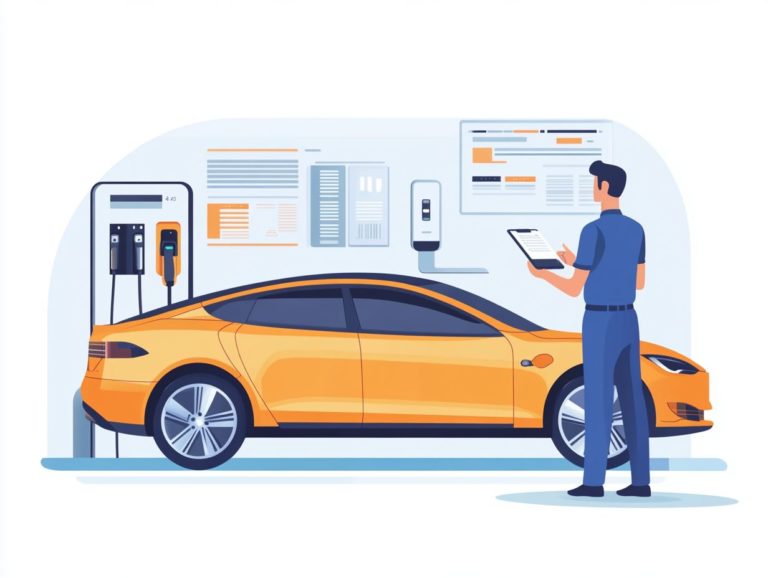10 Must-Have EV Maintenance Guides
As electric vehicles (EVs) continue to rise in popularity, grasping the nuances of caring for these remarkable machines becomes paramount for every owner.
Proper maintenance not only enhances performance but also significantly extends the lifespan of your vehicle.
This article presents ten essential maintenance tips, covering everything from battery care to tire inflation and keeping your EV spotless.
You ll uncover how regular check-ups can save you money over time while ensuring a smooth and efficient driving experience.
Dive in to explore the insights awaiting you!
Contents
- Key Takeaways:
- 1. Understanding the Basics of Electric Vehicles
- 2. Regularly Checking and Maintaining the Battery
- 3. Properly Inflating Tires for Optimal Performance
- 4. Keeping the Vehicle Clean and Free of Debris
- 5. Checking and Replacing Brake Pads as Needed
- 6. Maintaining the Cooling System for Battery Health
- 7. Avoiding Overcharging the Battery
- 8. Properly Storing an Electric Vehicle
- 9. Regularly Inspecting and Replacing Worn-Out Parts
- 10. Keeping Up with Software Updates and Recalls
- How Often Should an Electric Vehicle Be Serviced?
- Frequently Asked Questions
- What are the top 10 must-have EV maintenance guides for electric vehicle owners?
- How often should I perform battery maintenance on my electric vehicle?
- Is it necessary to check the tire pressure on my electric vehicle?
- Do I need to update the software on my electric vehicle?
- Should I have my brake fluid checked on a regular basis?
- How can I properly charge my electric vehicle?
Key Takeaways:

- Regular maintenance of an electric vehicle’s battery is crucial for optimal performance and longevity.
- Properly inflating tires and cleaning the vehicle regularly can improve overall performance and efficiency.
- Inspecting and replacing worn-out parts, keeping up with software updates, and avoiding overcharging can further extend the lifespan and save on long-term costs.
1. Understanding the Basics of Electric Vehicles
Electric vehicles (EVs) signify a remarkable evolution in automotive technology, presenting you with an eco-friendly alternative to traditional gas-powered cars. They not only significantly reduce carbon emissions but also come with lower maintenance costs, making them increasingly appealing to environmentally conscious consumers.
Unlike internal combustion engines, electric motors deliver a smoother driving experience. They require specialized maintenance to optimize performance and enhance the lifespan of your electric car.
Among the diverse options available, models such as the Ford F-150 Lightning and Chevrolet Bolt showcase the impressive variety of electric vehicles on the market today. These vehicles harness rechargeable batteries to power electric motors, providing you with quick acceleration and a whisper-quiet ride.
The advantages of EVs go beyond their positive environmental impact; they also offer lower fueling costs and superior efficiency.
Regular maintenance is essential for electric vehicles, as it allows you to monitor battery health, ensures efficient operation, and extends the vehicle’s overall lifespan. By prioritizing 5 simple EV maintenance tasks for beginners, you can safeguard the investment you’ve made in your EV.
2. Regularly Checking and Maintaining the Battery
Checking and maintaining the battery of your electric vehicle is essential for maximizing battery life, ensuring optimal performance, and enhancing safety. This also helps preserve the battery warranty provided by manufacturers.
This proactive approach helps you avoid unexpected breakdowns and those dreaded expensive repairs. It involves monitoring the battery’s battery level, temperature, and overall health. Regular inspections can catch early signs of wear or degradation, allowing for timely interventions that can save you from future headaches.
To assess battery health, utilize apps or dashboard indicators that offer insights into performance metrics. When it comes to servicing, it s crucial to select certified service centers specializing in EVs. This ensures that technicians have the expertise and tools necessary to handle battery maintenance effectively, keeping your vehicle in top shape.
3. Properly Inflating Tires for Optimal Performance
Properly inflating your tires is crucial for achieving optimal performance in your electric vehicle. Under-inflated tires can lead to higher maintenance costs and negatively impact both your driving experience and battery efficiency.
Maintaining the correct tire pressure enhances your safety and maximizes your vehicle’s range, allowing for smoother acceleration and improved handling. Regular tire rotations are equally important; they promote even wear and enhance the life of your tires, saving you money in the long run.
For electric vehicle drivers, proper tire inflation significantly affects battery consumption. Under-inflated tires require more energy, leading to quicker battery depletion. Routine maintenance checkups enable you to catch tire issues early, such as uneven wear or damage, preventing minor problems from escalating into costly repairs.
Ultimately, paying attention to tire care is vital for ensuring a safe and efficient driving experience.
Start your EV maintenance journey now for a ride that s smooth, safe, and eco-friendly!
4. Keeping the Vehicle Clean and Free of Debris
Keeping your electric vehicle clean and free from debris is crucial for maintaining its aesthetics and functionality. It significantly contributes to the overall maintenance and quality upkeep of the vehicle. Regular cleaning boosts the visual appeal of your ride and prevents the accumulation of dirt and grime that can adversely affect performance over time.
Neglecting this simple task can lead to issues like reduced efficiency, increased wear on the paint, and even mechanical problems caused by blocked sensors or systems. Don t wait! Wash your vehicle every two weeks to keep it looking sharp and performing at its best. Pay special attention to sensitive areas like the wheels and undercarriage.
Inside, maintain a pristine environment by vacuuming and wiping down surfaces weekly. This reduces allergens and odors for a more enjoyable driving experience.
5. Checking and Replacing Brake Pads as Needed
Your safety depends on regular checks of your brake pads. Regularly checking and replacing them is essential for maintaining the efficiency of regenerative braking systems in your electric vehicle. Watch for signs of wear, such as squeaking noises or reduced responsiveness. These are clear indicators that it might be time for a change.
Also, pay attention to the quality of your brake fluid. It significantly impacts your braking performance. Regular fluid assessments help spot potential issues early and contribute to the overall longevity of your braking system.
To maximize your vehicle’s safety, schedule maintenance visits at recommended intervals. This ensures that both your brake pads and fluid are consistently evaluated and refreshed as needed.
6. Maintaining the Cooling System for Battery Health

Maintaining the cooling system is crucial for preserving battery health in your electric vehicle. It helps keep the battery cool and prevents overheating, both of which can significantly impact battery performance.
An efficient cooling mechanism ensures your battery operates within its optimal temperature range. This extends its lifespan and enhances overall efficiency. Regular checks of the cooling system are essential. They allow you to identify potential issues before they escalate into significant problems.
By monitoring coolant levels, inspecting hoses and connections for leaks, and ensuring that cooling fans are functioning properly, you can greatly enhance your battery’s longevity. Routine maintenance, including flushing the coolant system as recommended by the manufacturer, keeps the cooling system effective.
7. Avoiding Overcharging the Battery
Overcharging can ruin your battery! Avoiding overcharging your battery is essential for extending its life and protecting the integrity of your electric vehicle’s warranty. Excessive charging can lead to irreversible damage that you definitely want to sidestep.
Many users may not realize that consistently overcharging impacts performance and can significantly shorten the overall lifespan of the battery. To mitigate these risks, establish a reliable monitoring system for your charging habits. Use mobile apps or in-car systems that alert you when your vehicle reaches optimal charge levels.
Strictly adhere to manufacturer guidelines regarding battery care. These specialized recommendations protect battery health, ensuring that your investment serves you well and remains compliant with warranty conditions.
8. Properly Storing an Electric Vehicle
Properly storing your electric vehicle is crucial for maintaining its condition and extending its lifespan, particularly during those lengthy periods of inactivity. By adhering to a well-structured maintenance plan and utilizing 5 tools for DIY EV repairs, you can safeguard your investment.
Start by charging your vehicle to around 50-70% before storage; this sweet spot helps prevent battery degradation over time. It’s also essential to regularly check tire pressure and coolant levels since both play a significant role in your vehicle’s overall health.
Consider utilizing a dedicated storage space that shields your vehicle from extreme temperatures. This will enhance battery efficiency.
Establishing a routine to periodically inspect your vehicle will greatly aid in preserving its functionality during extended storage periods.
9. Regularly Inspecting and Replacing Worn-Out Parts
Regularly inspecting and replacing worn-out parts is essential for effective electric car maintenance. This allows you to avoid unexpected replacement costs while ensuring both safety and efficiency.
Conducting routine checks on key components like the battery, brakes, and tires not only extends the life of your vehicle but also significantly boosts its overall performance. These inspections enable you to catch potential issues early on, which, if ignored, could escalate into costly repairs or even jeopardize your safety on the road.
By staying proactive with maintenance, you can maximize your electric vehicle’s efficiency, ensuring optimal energy use and prolonging the lifespan of critical systems. Checking out 5 ways to keep your EV running smoothly can help you maintain regular attention to these areas, protecting you from unforeseen breakdowns, offering peace of mind, and promoting a smoother, more enjoyable driving experience.
10. Keeping Up with Software Updates and Recalls
Don t miss out! Keeping up with software updates and recalls is key to keeping your electric vehicle safe and efficient. This allows it to perform at its best with the latest technological advancements.
These updates bring enhancements in energy efficiency, battery management, and even improvements in driving dynamics. All of which can notably elevate your overall driving experience.
As vehicle systems grow increasingly complex, the importance of EV technicians escalates. They not only keep tabs on recall information to ensure compliance with safety standards but also offer insights into the latest software versions that can optimize operational efficiency.
By regularly accessing these updates, you can take advantage of advanced features while protecting your investment. Make it a habit to check for updates regularly your vehicle will thank you!
How Often Should an Electric Vehicle Be Serviced?
Understanding how often you should service your electric vehicle is crucial for maintaining its optimal performance. A regular maintenance schedule not only helps prevent issues but also extends the lifespan of your vehicle.
Generally, components like batteries, brakes, and motors have specific service intervals to ensure they function effectively. For example, it’s often recommended that you check your battery every 20,000 to 30,000 miles. Brake systems might go longer without needing attention, thanks to brakes that recharge the battery when you slow down.
Don t overlook how your driving habits such as frequent fast acceleration or long-distance travel can significantly impact your service requirements. By making regular maintenance visits, you can catch potential problems early and keep your vehicle running efficiently, ultimately contributing to sustainable transportation practices.
What Are the Most Common Maintenance Tasks for an Electric Vehicle?

Common maintenance tasks for electric vehicles include battery checks, tire rotations, and brake inspections. Following the best practices for maintaining your EV is critical for ensuring your driving experience is safe and efficient.
Battery checks let you identify potential issues early, prolonging your EV’s power source lifespan. Tire rotations promote even wear and optimal traction, greatly improving your driving safety.
Brake inspections are non-negotiable as they ensure your vehicle can stop effectively. This is crucial for navigating city streets.
Don’t overlook the importance of regular maintenance checkups that include software updates and coolant level assessments. These elements significantly impact your vehicle’s efficiency and operational safety, making them essential for any responsible EV owner. For more insights, check out a guide to EV maintenance costs.
What Are the Benefits of Regular Maintenance for Electric Vehicles?
Regular maintenance for your electric vehicle helps you lower costs and ensures long-term savings by enhancing battery life and overall performance. Utilizing essential tools for EV maintenance at home can make this process even more effective.
By keeping up with routine servicing, you can spot potential issues before they become expensive repairs. This proactive approach maximizes your vehicle s efficiency and boosts its resale value.
Regular check-ups contribute to the overall health of your vehicle, reducing the chances of unexpected breakdowns. Consequently, maintaining your electric vehicle will help you charge less often, making your driving smoother and more enjoyable!
Can Electric Vehicles Be Serviced at Any Mechanic?
You might handle some basic maintenance tasks yourself, so check out these DIY maintenance tips for electric vehicles, but it’s best to take your electric vehicle to certified service centers specializing in EV maintenance.
These facilities employ technicians with the right qualifications and training in powerful battery systems and electric powertrains. Professionals need a deep understanding of the unique technologies that electric vehicles use; improper handling can lead to significant risks.
As electric vehicle popularity surges, the demand for skilled technicians is high. To locate certified service centers, check manufacturer websites, explore online directories, or reach out to local EV clubs for tailored recommendations.
What Are the Long-Term Savings of Proper EV Maintenance?
Proper maintenance of electric vehicles can lead to significant long-term savings, including lower maintenance expenses and an extended lifespan for your car a financially savvy choice.
Prioritizing regular check-ups and timely service keeps repair costs at bay while enhancing your battery’s health, maximizing range. Consistent upkeep helps you identify and address minor issues before they snowball, prolonging the life of key components.
This proactive approach leads to a smoother driving experience and ensures your vehicle retains its value over time, ultimately benefiting your wallet.
By focusing on maintenance, you can appreciate your vehicle’s longevity and reliability, highlighting the importance of this investment for the long haul.
How Can One Extend the Lifespan of an Electric Vehicle?
Extending the lifespan of your electric vehicle requires proper battery maintenance, regular inspections, and mindful driving habits.
These practices foster the overall health of your vehicle. To achieve the best battery performance, it s essential to stick to a regular maintenance plan. This means keeping a close eye on battery levels and steering clear of letting the battery get too low.
Additionally, strive to charge your vehicle within a moderate temperature range. Extreme heat or cold can harm battery health. Embracing smooth acceleration and gentle braking can significantly enhance overall efficiency.
These driving habits ease the strain on the battery, ultimately benefiting your vehicle’s longevity. Follow these practical tips to enjoy a longer-lasting electric vehicle and reap the rewards of sustainability without the hassle of frequent replacements.
Frequently Asked Questions
What are the top 10 must-have EV maintenance guides for electric vehicle owners?

The top 10 must-have EV maintenance guides for electric vehicle owners include battery care, tire pressure checks, regular software updates, brake fluid checks, proper charging techniques, keeping the exterior clean, scheduled maintenance appointments, inspecting cooling systems, checking and replacing air filters, and understanding warranty coverage. For more details, explore these 10 quick maintenance checks for EV owners.
How often should I perform battery maintenance on my electric vehicle?
Check your battery at least once a month for best performance. This includes monitoring the battery’s state of charge, temperature, and cleaning any corrosion from the terminals.
Is it necessary to check the tire pressure on my electric vehicle?
Yes, regularly checking the tire pressure is important. Properly inflated tires improve efficiency, ensure safe handling, and reduce the risk of blowouts.
Do I need to update the software on my electric vehicle?
Yes, regular software updates are essential for maintaining performance and safety. These updates can improve battery efficiency, fix bugs, and add new features to your vehicle.
Should I have my brake fluid checked on a regular basis?
Yes, it is recommended to check your brake fluid every 12 months or 15,000 miles, whichever comes first. Over time, brake fluid can absorb moisture and become less effective, potentially causing brake failure.
How can I properly charge my electric vehicle?
To properly charge your electric vehicle, use a dedicated EV charging station whenever possible. Avoid using extension cords or power strips, and make sure to use the correct charging voltage for your vehicle. It is also important to avoid overcharging the battery.

